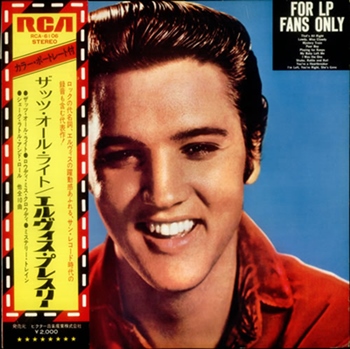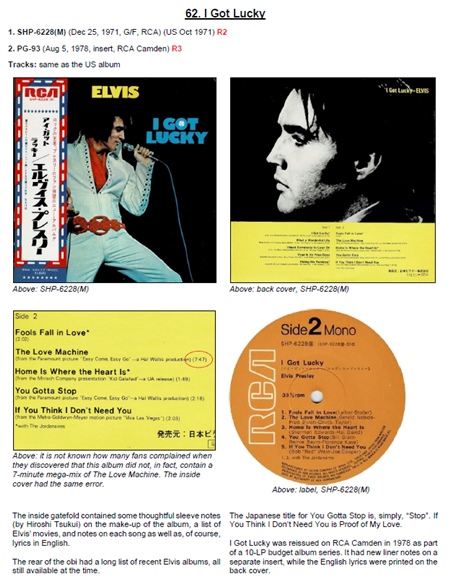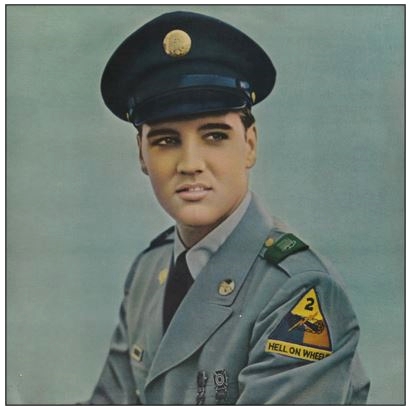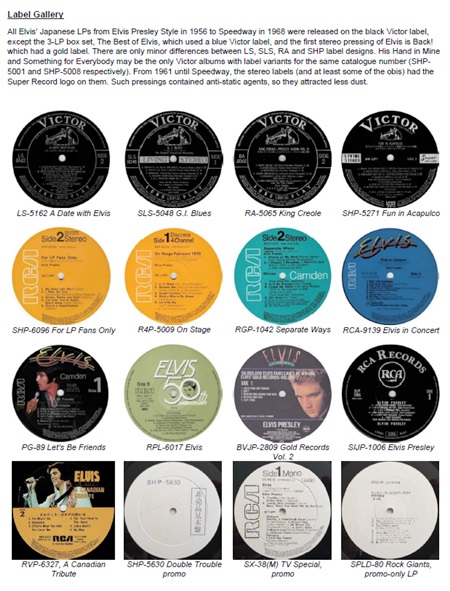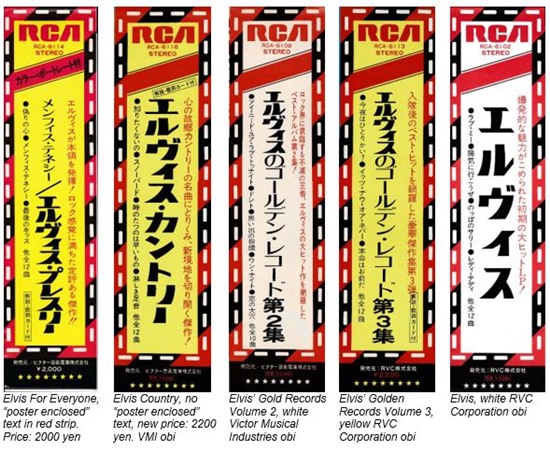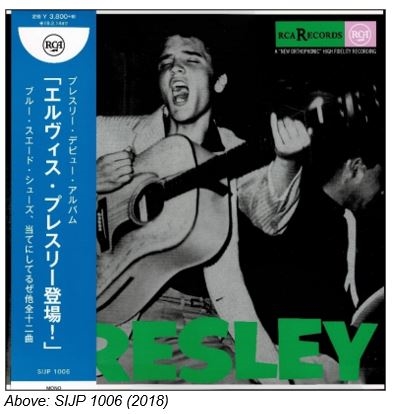 |
 |

Coming soon to EIN: 'From Elvis in Japan' book review A new e-book by David Ward chronicles more than 100 Japanese Elvis LPs in great narrative detail and glorious color images. Long-time collectors will be very aware of how different many Japanese Elvis records were and how much extra effort RCA Japan put into them. David recently took time out to discuss his book with EIN’s Nigel Patterson. The result was a fascinating interview..... EIN: David, many thanks for your time today. Who is David Ward? DavidWard: Ha-ha. You want to start with the heavy stuff, eh? That’s possibly the hardest question you could ask. It must have been a question Elvis pondered too. As you know, he had two songs with the words “Who am I?” in the title. To keep it simple, I’m an Englishman who’s spent most of his adult life in Japan where I teach English to scientists at a university in Tokyo. EIN: How and when did you become an Elvis fan? DW: It goes back to one of my most vivid childhood memories. Among my mother’s collection of battered old 45s from the 1960s was an original UK copy of A Mess of Blues. The Girl of My Best Friend was on the B-side and that was the first song ever to really get to me. It affected me in ways I still don’t understand. I was only 6 or 7 years old but somehow I really felt for the poor guy in the song. I’d already had my first kiss by then so perhaps that had something to do with it. I still love that song to this day and of course I have a decent copy of that same UK original record. Coincidentally, when I was 9, the single was reissued with The Girl of My Best Friend as the A-side. It got into the Top 10 all over again. I also remember pretending to be Elvis Presley when playing soldiers with my brothers and a friend, so I must have seen his films at an early age. This was before he died. I wasn’t in a position to buy his records until I was about 12 or 13, in the late 1970s. The first one I bought was a Canadian copy of His Latest Flame / Little Sister in a picture sleeve. Like a lot of other people, I sold all my records in the early ‘90s but that single is one that I’ve since bought again. EIN: You recently published your ebook, From Elvis in Japan: Elvis Presley Japanese LPs 1956 – 2018. How did the book come about? DW: I’ve been writing in my spare time for many years, mainly fiction, but I’d always wanted to write an Elvis book. I often found myself referring to the Japanese Elvis Record Covers book, which was published many years ago, when preparing for my videos for my YouTube channel, Elvis Presley in Japan. The book has a lot of colour photos of the album front covers but almost no text. I initially thought about approaching the publishers with the idea of reprinting it with my English text. But then I thought, why not do the whole thing from scratch with more photos. EIN: It must have been difficult obtaining information on all 131 of Elvis’ Japanese LPs. How did you go about sourcing information and cover and label images for each listing? DW: Many of the images I already had because over the years I’ve submitted literally hundreds of records and CDs to Discogs (an online music database and marketplace) from my own collection. I also received a lot of great images from a couple of Elvis collector friends in Europe who have far better collections than mine. It wasn’t difficult finding out which albums had been released in Japan, the 131 titles, but finding out about all the variants wasn’t always straightforward. The most popular albums have been released on vinyl more than a dozen times. In fact, what we’re really talking about is obi variants, not cover or record variants, of which there are fewer. In Japan, the manufacturer determines the retail price, not the retailer. One tactic they used to create the impression of a new release is to put an album out again with a different obi. They also used this strategy to get rid of old stocks – same record, same cover, different obi. I think that’s one reason why there were so many series of Elvis records in Japan. (EIN Note: An obi is the identfication strip wrapped around the spine of Japanese CDs, or books sometimes referred to as a "spine card". The term obi (帯) designates the sash around a kimono.)
EIN: How long did it take you to research and write the book? DW: Without realizing it, I’d actually started writing the book years before I formally began by, as I mentioned, being very active on Discogs. All the work I’d put in submitting those records and CDs turned out to be the backbone of the research for this book. Once I’d decided to gather all the information I already had, it took me less than a year to put the book together. I will say, though, I’ve discovered dozens of variants that I knew nothing about a year ago. EIN: What was the first Elvis album released in Japan? DW: That was a 10” LP with the same front cover as the first American album, Elvis Presley. It was released on the Victor label and only had 8 songs and only 5 songs in common with the American LP. It included both sides of Elvis’ first US RCA single. Although the front cover and labels read Elvis Presley in English, the title in Japanese on the back cover is Elvis Presley Style. It came in an integral plastic cover. You couldn’t take it off because if you did you’d just be left with two pieces of card. A couple of singles and several EPs were released in similar covers but no more albums.
EIN: When was the original Elvis Presley album released? DW: That one didn’t come out until 1962 when the first electronic stereo albums “escaped” (to borrow one of Elvis’ jokes). There are a couple of interesting things about those Elvis Presley albums from 1962. The mono version actually plays in stereo, despite having mono matrix numbers. And both records, stereo and “mono”, were pressed on vinyl that appears olive-green when held up to a bright light. Other albums from around that period (1961 to 1963) were pressed on the same kind of vinyl but some copies were also released with the usual opaque vinyl. That semi-translucent vinyl is a mystery I’m still trying to get to the bottom of. The Elvis Presley LP wasn’t released in proper mono in Japan until 1985. The Japanese embraced stereo pretty quickly, actually. Fun in Acapulco was the last album released in both mono and stereo. EIN: Were all of Elvis’ LP releases in the US issued in Japan? DW: Most of the ones released in the US up to 1987 were also issued in Japan, although not always at the same time. For LP Fans Only didn’t appear in Japan until 1963 and, unbelievably, that was the first time That’s All Right appeared on any record in Japan, LP or otherwise. For some reason, the Japanese passed on Elvis Sings for Children and Having Fun with Elvis on Stage. The box sets, Elvis Aron Presley, and A Golden Celebration, were imported from the US and repackaged for the Japanese market. Japanese customers got the US releases plus Japanese hype stickers and, in the case of A Golden Celebration, a Japanese booklet. When Return of the Rocker was released, according to the Japanese liner notes it was the 95th album released in America. It is number 128 in my book, so the Japanese were well ahead at that stage. EIN: RCA Japan was well known for the extra effort it put into Elvis LPs. What can you tell us about this? DW: I think this started with the Victor compilation albums, Elvis’ Golden Story Volume 1 and Volume 2, released in 1965. They were lavishly packaged in gatefold sleeves with a calendar, colour photo, many black and white pictures and lots of information on the inside. They even released the albums with a special “star” obi. These albums both sold really well (judging by the number of used copies on the market today) and perhaps they had that in mind when it came to releasing the TV Special album. That was the first of several live albums that were given the same special treatment: gatefold covers, colour photos, black and white photos and tons of info. They charged for it, of course. The live albums initially retailed at 2,200 yen, whereas the other albums were only 1,800 yen. They were taking a bit of a gamble by spending so much on the packaging of that TV Special album because Elvis’ records hadn’t been selling well for quite a while at that time. Before the TV Special, you have to go back to Elvis for Everyone for an album that’s not difficult to find. Never mind the soundtracks, How Great Thou Art and Gold Records Volume 4 are tough albums to find. I think nearly all the albums from the TV Special to Aloha are worth having just for the packaging. Even the first four Camden albums (which were actually released on the orange RCA label in Japan) were in gatefold sleeves.
EIN: RCA Japan also frequently included the lyrics to Elvis songs as part of the LP releases. You cover this in your book, drawing attention to some of the transcription errors and very funny English translations. What were some of the funniest? DW: Strictly speaking, there were almost no albums with Japanese translations of the lyrics, but virtually every album had transcriptions of the English lyrics, either on the cover or on an insert. I hesitated before including examples of the transcription errors in the book because the Japanese are not known for being great English speakers and there was obviously no internet back then. Occasionally, though, they did remarkably well which makes me think they must have had access to sheet music in some cases. The transcribers were never named on the artwork so I decided to include a few examples in the book. One of my personal favourites is “There’s nothing in the way you kiss that makes me want to hold you tight” from It Feels So Right. Very romantic. And you have to feel sorry for the poor soul who had to transcribe the lyrics for A Little Less Conversation. The transcription is full of errors. For instance, where Elvis sang, “It’s a groovy night and I can show you how to use it”, the transcriber came up with, “It’s a groomy a night and night I’m chocky how to use it”. Actually, I read a fascinating interview with a guy who designed the covers for the Japanese Beatles singles in the 1960s and his working days were just manic. It must have been a nightmare for the people transcribing the words too. They wouldn’t have been very high up in the company, probably already stressed out, and then A Little Less Conversation gets slapped on their desk. Frank Zappa actually employed a guy to oversee all the lyrics to his Japanese CDs because he’d had no control over the records and he wanted to make sure the job got done properly. Transcribing is not always easy, even for native English speakers. I went through a big Bob Dylan phase when I was in my late teens. I used to write down his lyrics in a notebook and it was sometimes frustratingly difficult. And when I was a kid, in Can’t Help Falling in Love, I was convinced Elvis was singing “Darling, solid gold, some things are meant to be”. EIN: What were some of your favorite discoveries in researching the book? DW: Little things like noticing there were two slightly different covers for the 1950s pressings of Loving You and Elvis’ Christmas Album. It amazed me that there could be variants when so few copies were made. I’m pretty sure those first ‘50s albums were deleted by the time Elvis Is Back! came out. I learned some interesting things from a book about Elvis’ albums written by a woman called Reiko Yukawa who wrote the sleeve notes for many Elvis albums. She describes how there was almost no information on Elvis’ music at all in the early days. There was literally one music magazine in Japan and it didn’t devote much space to “western” music. It’s no wonder those early Elvis records are so rare. You would have had to be one of the cool kids just to know his records existed. I mentioned that the transcribers were never credited (not sure they would have welcomed it, to be honest) but neither were the people who wrote the sleeve notes in the early days. Reiko Yukawa points out that there was no such job as music journalist at the time, and those writers were lowly company employees. The sleeve notes were strictly factual in the early days but, as time went on, the writers started including their opinions too, so they became more like an article you might expect to see in a music magazine. Of course, they were always positive. They were there to help sell the records, after all. I also learned a few interesting titbits from reading the Japan Elvis Monthly magazine. For instance, when the record company was planning to re-release ten of the ‘60s soundtracks in 1982, they discovered they didn’t have all the artwork they needed so they borrowed some US originals from the fan club president and used those to make the Japanese covers. I don’t know which titles he lent them, but I suspect Girls! Girls! Girls! was one of them because the cover of that reissue is quite grainy. I think something similar happened with the many reissues of That’s the Way It Is. All the post-1972 covers have ring wear at the bottom that was there from the start which makes me think they must have used an old US copy. Japanese originals were laminated, so they didn’t get ring wear. Discovering there were more early 1960s albums with red obis was also a nice surprise. I was only aware of one, but now I know there were six (three mono and three stereo). That gives you some indication of how rare they are, even in Japan. Almost all the other albums from that period had blue obis.
Japan's 'Elvis’ Golden Records Vol. 2'
EIN: I note that the Japanese Elvis’ Golden Records Vol. 2 release was quite different to what most fans are familiar with, in that it did not feature Elvis in his famous gold lamé suit nor include the usual track listing. What can you tell us about this release? DW: The reason for the album and cover being so different is surprising but simple – the Japanese release came out six months earlier than the US Gold Records Volume 2 LP. It also came hot on the heels of Elvis’ Golden Records, which was released in March 1959 in Japan, a full year after they got the album in America. The Japanese album, Elvis’ Golden Records Vol. 2, was the first one released with an obi, to my knowledge. A copy with its obi recently sold on a Japanese auction site for around $2,000.00. The front cover is the same as the back cover of the US For LP Fans Only album, and I think the Japanese album was based on that LP. Not only does it use that same Elvis in uniform photo, it says “For LP Fans Only” in English on the back cover in smaller letters beside the title, Elvis’ Golden Records, Vol. 2. It also has 6 of the 10 songs that were on LP Fans. EIN: What are some of the more notable “Japan only” Elvis LP releases? DW: Without a doubt, the 1950s albums with unique covers are the most appealing to collectors, especially the Christmas Album with its “baubles hanging from a Christmas tree” design and fantastic old-fashioned fonts, and Loving You which has a full-length picture of Elvis wearing his snappy western duds while holding that big Gibson guitar. That LP also has a few different songs on Side 2, including Jailhouse Rock and Treat Me Nice. My favourite is the 1985 box set, The Complete Singles, an 11-LP box set released as part of the 50th Anniversary series. It brings together all of Elvis’ US A-side singles up to the mid-80s and also has an album full of songs that appeared on singles in Japan. Just looking at the songs that are on there really brings it home how many great singles he made. Even in the lean years of the mid-1960s, he was never far away from releasing a fantastic single. That box set also came with a special offer of a free single with U.S. Male on one side and Mama Liked the Roses on the other. They gave away good stuff in Japan. If you’ve got a copy, hold it up to the light. It’ll probably appear brown. The albums do too. EIN: Do you have a favorite Elvis Japanese LP cover or covers? DW: There was an album called Rock Elvis Rock! released in 1958. It used the same cover as Elvis’ Golden Records and the title was in the same blue lettering used on the first US release of Golden Records. Most covers that turn up look like they’ve been rubbed in the ground but a near-mint cover of that album is a thing of beauty. I also really like the cover for the double LP, Rock’n Roll Album, released just before Elvis died. It has some great cover shots from the photo session that produced the All Shook Up 45 cover photo. Another favourite is the 1970 RCA pressing of A Date with Elvis which uses a photo from around 1956 before Elvis dyed his hair. You can even see his pimples.
EIN: Some collectors are particularly interested in promo releases. You feature these in your book. How many Japanese Elvis LP promo albums have you identified? DW: I’ve seen promo copies of most, if not all of the albums from the mid-60s onwards. Before that, the picture is a little murky but I have seen promo copies of some early albums. The last Victor albums came with green labels. I’d quite like to get them. Believe it or not, the last couple of RCA albums, released in 1987, are easier to find in white label promo versions than the standard orange label versions, which gives you some idea how far sales of records had fallen behind CDs by that point. Although I use several photos of promo album labels in the book, I haven’t listed them as separate releases. Readers can assume that promo versions of most albums are out there and that the vast majority are white. EIN: An interesting Japanese promo album featured in your book is RCA Special Highlights Test Record. What is the story behind this? DW: Elvis’ songs had featured on many Victor and RCA promo-only compilations since around 1964. They usually only contained one Elvis song along with songs by other artists on the same label. Other record companies put out similar compilations too. The album you’re referring to contained a whole side of Elvis’ music which is why it’s included in my book (I haven’t included the ones with just one or two Elvis songs). It was released to promote the Recorded Live on Stage in Memphis album. One side of the record contains several songs from that LP. On the other side of the record were several songs from a Perry Como album called Perry. He was also on RCA, of course. There were also two other compilations featuring the music of Elvis, Paul Anka, and Neil Sedaka, one of which was also a promo-only release.
EIN: Another interesting release in From Elvis in Japan is the 1980, 50 track, 4 LP box set, By Request of Japanese Fans (with the great “tear drop” image on the cover). Politics was at play in the 50 songs that were included, with RCA being quite mean spirited. Please tell us about this. DW: Well, most fans know how Tom Parker and RCA struck a deal whereby Parker sold Elvis’ royalty rights to RCA in exchange for a lump sum of money. This meant Elvis only earned royalties on the songs he released after 1974. The idea behind this particular box set was that it would include the 50 most popular songs in Japan, as voted for by members of the Elvis Presley Fan Club of Japan. When the votes came in, it turned out that, among the 50 most popular, there were 5 songs that had been recorded in 1975 or later. RCA in America said, “Yes, you can release this compilation but you can’t include those 5 songs”. So the last 5 tracks on the box set are not, in fact, among the 50 most popular songs (the set is arranged, in theory, from most popular to 50th most popular song). I thought it was very honest of the Japanese record company to point out the omissions.
EIN: Many EIN readers would not be aware of RCA’s 1973 Poster series of 20 Elvis LPs. How did this series come about and how big were the posters? DW: This series came out just after the release of the Aloha TV show and album in 1973. Elvis’ popularity would never be as high in Japan after Aloha, but they cashed in on it at the time by reissuing twenty of his most famous LPs, each of which came with a colour poster measuring 24” x 12” (60cm x 30cm). All the posters featured pictures of Elvis on stage, many of them from the Elvis on Tour film and several taken by Yoshiji Kizaki, a Japanese man who also wrote sleeve notes for several Elvis albums. These records are quite hard to find with their posters, presumably because people hung them on their walls before throwing them away at some point. All the albums were quickly reissued with slightly different obis but without the posters. That series includes the only Japanese release of Back in Memphis as a single record. EIN: Obi strips were very common on Japanese Elvis LPs (and you devote a section to them in the book). What did you find out about them? DW: I began looking at obis more closely after I started doing YouTube videos in September 2020 and, as a result, I learned about a free RCA booklet that was offered on early ‘70s albums, and something called a Mini Capsule (a mini Victor gramophone inside a clear, heavy plastic cube), both of which I now have in my collection and both of which I’ve done videos about. I’m still trying to track down the calendar that was offered with the original stereo pressing of Golden Records Volume 3.
EIN: Did you consider including a price guide for each listing? DW: Late in the process of writing the book, I came up with the idea of a rarity grading to help collectors get an idea of how rare their records are. So every single variant of every album is rated from 1 to 5 on a rarity scale. I never considered a price guide because there are too many rare variants that I’ve never seen for sale, so I wouldn’t know what they were worth. Prices also tend to be lower in Japan for post-1950s releases than they are outside Japan. The demand for his 1950s records, however, is still as high in Japan as anywhere else. Although I think that’s partly due to dealers bidding aggressively in online auctions and then flipping the records on eBay. EIN: Are sales figures available for Elvis’ Japanese record releases? DW: According to the Moody Blue album liner notes, his album sales in Japan in 1977 stood at 2 million, while sales figures for singles were 5 million. Those figures will have risen sharply after his death, of course. A newspaper article published the day after he died listed his ten top-selling albums at that time. The biggest seller by a country mile was That’s the Way It Is with sales of 300,000 at the time, a huge amount for a non-Japanese artist. The album actually spent 16 weeks at number one and I’ve identified 17 different Japanese versions. And that’s just LPs. At that time, the early 1970s, Simon & Garfunkel and The Carpenters were also huge in Japan. Elvis’ second biggest album was On Stage with sales of 160,000 by August 1977. These numbers may not sound particularly impressive but look at it this way: how many Japanese artists were selling records in similar quantities overseas? Six of Elvis’ top ten selling albums were live records (if you include TTWII) and the only live album not in that list is Recorded Live on Stage in Memphis, although that too sold well. The first pressing of that album is worth looking out for because the obi doubled as a poster that wrapped right around the cover, so the first thing you see is not a photo of Graceland, but a picture of Elvis in a black jumpsuit. EIN: You chose to publish From Elvis in Japan in ebook format. Is there any chance of a "physical” edition? DW: I wanted to make the book available on Amazon so people could have the option to print a copy if they wanted. Unfortunately, the original book file uses tables, and Amazon’s kindle technology can’t handle tables. I tried to format the book using their Kindle Create software but it looked a mess. To actually print the book at my own expense would be too costly in Japan, given the limited market for such a book. Although if FTD were to come knocking, I’d be interested. Are you reading this, Ernst?
EIN: Are many of Elvis’ Japanese LPs still available? DW: The only one still available right now in 2021 is the 2018 reissue of Elvis Presley, SIJP 1006. It sounds superb, by the way. It was remastered by Sony in Japan. The obi design is also very similar to the one on the 1962 pressing. Apart from that one, no other album has been manufactured in Japan since 1992, apart from a promo-only copy of the 10” Love Me Tender album, originally released in 1957, another Japan-only release. EIN: For those fans wanting to buy Japanese Elvis LPs, what are the best options/outlets? DW: the most obvious ones would be eBay and Discogs. You should check the seller’s feedback carefully if you use Discogs, but most Japanese dealers can be trusted. I’ve bought many items on Yahoo! Japan Auctions and people outside Japan can also use this website, even if they can’t read Japanese, by bidding through jauce.com. It can get quite expensive, though, because you have to pay domestic shipping, international shipping, and taxes on top of the price of the item. Also there are many private sellers on Yahoo! and many of them don’t know how to grade records properly. Prices of Elvis’ Japanese releases have come down greatly in the last ten years, though, due to more product coming onto the worldwide market as more Japanese dealers are now selling on eBay and Discogs. At one time, they seemed reluctant to sell to overseas buyers because of the language barrier, but I guess the demand got too great to ignore. EIN: Elvis has always been very popular in Japan. How would you characterize his popularity there today? DW: I think more people would like his music if they got to hear it. You just don’t see or hear anything about Elvis anymore. I saw a TV show a few years ago where the presenter went out and about in Tokyo, showing young people a photo of Elvis. “Do you know who this is?” he asked. Some of them said things like, “He looks cool” or, “Is he an actor?” but most of them didn’t know who he was. A few recognized his face but only one or two knew his name. Until a few years ago, there was an Elvis shop in Tokyo with a big statue of Elvis outside. It was located in one of the most fashionable parts of Tokyo, a place called Harajuku. I used to love going there but I didn’t enjoy weaving my way between hundreds of trendy kids between the station and the shop on sweaty summer afternoons. The owner moved his business to Memphis and, sadly, the statue is now in storage. Occasionally there are positive signs, though. The '30 #1 Hits' CD went platinum in Japan. EIN: Do you have any plans for another Elvis book? DW: I’m planning to start researching a book on all aspects of Elvis’ movies in Japan. Fortunately, almost all of them were screened here so there’ll be a lot to discover. It’ll also give me a reason to start studying Japanese again. I’ve been a bit lazy in that respect over the last 15 years or so. There’s a big market for movie programs and posters in Japan. Some of the original posters fetch thousands of dollars at auction. There are also some interesting stories related to the movies. Many of them have different titles in Japanese. Follow that Dream is “Dream Beach” in Japanese. The movie was first screened in Tokyo in September 1962 but to promote its release, Victor arranged for a motorcade of 100 vehicles, including an old banger like the one in the film, to travel along a 13-kilometre stretch of road that they dubbed “Dream Beach Highway”. There was a singer, Miyuki Yamanaka, on hand to cut the tape at the formal opening ceremony. Most of that route, understandably enough, takes you right along the coast. One day, when things get back to normal, I’m going to drive along that route myself. EIN: David, is there anything else you would like to say to EIN readers? DW: If you want to know anything about Elvis’ Japanese releases, feel free to get in touch with me through my YouTube channel. Also keep supporting the Elvis Information Network and keep flying the Elvis flag. And thanks very much to EIN for the interview. It’s been fun. EIN: David, many thanks again for talking to EIN today. We look forward to your Elvis films in Japan book. NOTE - 'From Elvis in Japan Japanese LPs 1956-2018' The eBook is priced at $10.00 and can be purchased as a download from Payhip at https://payhip.com/b/weJiv - Buyers will need a PayPal account.
|
|


